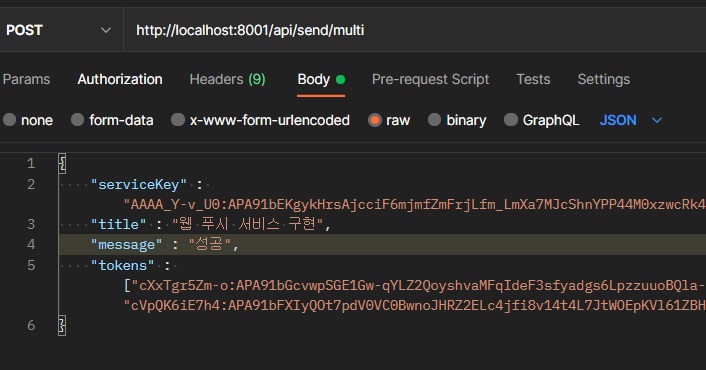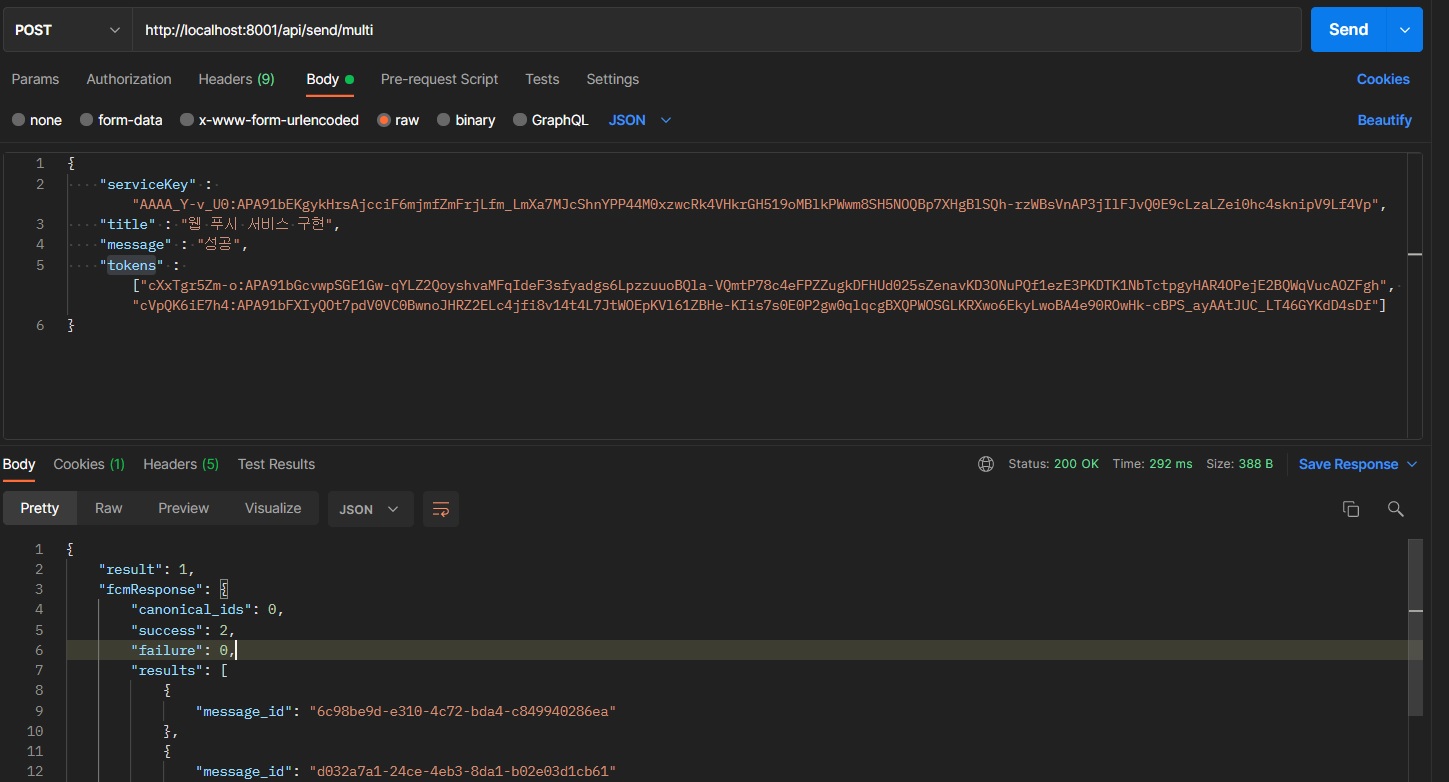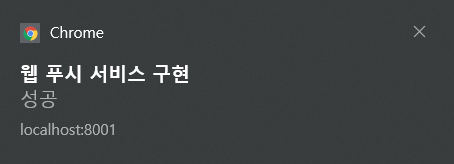FCM 서비스 이용, 푸시 서버 개발하기
TL;DR
안녕하세요, 이번 포스팅 주제로 Push 서버를 다뤄보려 합니다. 😊
FCM(Firebase Cloud Messaging) 이란 ?
- Google에서 제공하는 클라우드 메시징 서비스 플랫폼 입니다.
- 무료로 서비스를 사용할 수 있으며, 안정적인 서비스를 제공하기에 많은 기업과 개인에서 푸시 서버를 구축 시 선택하여 사용하는 서비스 입니다.
Google Firebase 플랫폼
FCM 서비스 세팅
1) 위 Firebase 접속 및 로그인 (Google 계정)
2) Firebase 프로젝트 생성
3) 프로젝트 설정, 클라우드 메시징 메뉴 내 “서버 키” 저장 보관
- (서버 사이드에서 FCM API 인증 시 이용)
4) 프로젝트 설정, 서비스 계정 메뉴 내 “새 비공개 키 생성” 저장 보관
- (클라이언트 영역에서 이용)
Push Server 구성
Push API 개발
[build.gradle]
dependencies {
...
compile group: 'com.google.firebase', name: 'firebase-admin', version: '6.8.1'
implementation 'org.springframework.boot:spring-boot-starter-thymeleaf'
...
}
[FcmSendRestApiController.java]
@RestController
@RequestMapping("/api")
public class FcmSendRestApiController {
static final Logger logger = LoggerFactory.getLogger(FcmSendRestApiController.class);
@Autowired
private FcmServerService fcmService;
@RequestMapping(value = "/send/multi", method = RequestMethod.POST)
public @ResponseBody ResponseEntity<Object> sendMultiDevice(@RequestBody FcmRequestDto req)
throws Exception {
HashMap<String, Object > responseMp = new HashMap<String, Object>();
long resultCode;
String serviceKey = req.getServiceKey() == null ? "" : req.getServiceKey();
String[] tokens = req.getTokens().length == 0 ? new String[0] : req.getTokens();
String title = req.getTitle() == null ? "" : req.getTitle();
String message = req.getMessage() == null ? "" : req.getMessage();
String notifications;
notifications = FcmDataUtil.pushMultiDataProcessing(tokens, title, message);
HttpHeaders headers = new HttpHeaders();
MediaType mediaType = new MediaType("application", "json", StandardCharsets.UTF_8);
headers.setContentType(mediaType);
HttpEntity<String> request = new HttpEntity<>(notifications, headers);
CompletableFuture<HashMap<String, Object>> pushNotification = fcmService.send(request, serviceKey);
CompletableFuture.allOf(pushNotification).join();
try {
logger.debug("request :: {}", request);
Object firebaseResponse = pushNotification.get();
responseMp.put("fcmResponse", firebaseResponse);
resultCode = CommonConstant.ResponseUtil.API_RESULT_CODE_SUCC;
} catch (InterruptedException e) {
responseMp.put("errorMessage", e.getMessage());
resultCode = CommonConstant.ResponseUtil.API_RESULT_CODE_FAIL;
} catch (ExecutionException e) {
responseMp.put("errorMessage", e.getMessage());
resultCode = CommonConstant.ResponseUtil.API_RESULT_CODE_FAIL;
}
responseMp.put(CommonConstant.ResponseUtil.API_RESULT_CODE_KEY, resultCode);
return new ResponseEntity<>(responseMp, HttpStatus.OK);
}
}
[BundleFcmRequestDto.java]
@Getter
@Setter
@ToString
public class BundleFcmRequestDto {
private List<FcmRequestDto> fcmBody;
private String serviceKey;
}
[FcmRequestDto.java]
@Getter
@Setter
@ToString
public class FcmRequestDto {
private String serviceKey;
private String token;
private String[] tokens;
private String title;
private String message;
}
[FcmDataUtil.java]
public class FcmDataUtil {
public static String pushMultiDataProcessing(String[] tokens, String title, String message)
throws JSONException, UnsupportedEncodingException {
JSONObject body = new JSONObject();
JSONArray array = new JSONArray();
for (String token : tokens) array.put(token);
body.put("registration_ids", array);
body.put("content_available", true);
JSONObject notification = new JSONObject();
notification.put("title", title);
notification.put("body", message);
body.put("notification", notification);
return body.toString();
}
}
[FcmServerService.java]
@Service
public class FcmServerService {
@Async
public CompletableFuture<HashMap<String, Object>> send(HttpEntity<String> entity, String serviceKey) {
RestTemplate restTemplate = new RestTemplate();
ArrayList<ClientHttpRequestInterceptor> interceptors = new ArrayList<>();
interceptors.add(new HeaderRequestInterceptor("Authorization", "key=".concat(serviceKey)));
interceptors.add(new HeaderRequestInterceptor("Content-Type", "application/json; UTF-8"));
restTemplate.setInterceptors(interceptors);
@SuppressWarnings("unchecked")
HashMap<String, Object> firebaseResponse = restTemplate.postForObject(CommonConstant.FIREBASE_API_URL, entity, HashMap.class);
return CompletableFuture.completedFuture(firebaseResponse);
}
}
- 위 내용들로 FCM 서버 인증 Key 및 알림 메세지등을 담아 푸시를 전송 표현할 API가 개발되었습니다.
전송 API 규격
# 푸시 전송 API
- url
+ (POST) /api/send/multi
- RequestType
+ JSON
- Parameter
+ serviceKey
:: FCM 서비스 인증 Key
+ title
:: 푸시 제목
+ message
:: 푸시 내용
+ tokens (배열)
:: 알림 받을 클라이언트 Token 값

테스트용 화면 구현
[index.html]
<!DOCTYPE html>
<html xmlns:th="http://www.thymeleaf.org"
xmlns:layout="http://www.ultraq.net.nz/thymeleaf/layout">
<head>
<script src="https://www.gstatic.com/firebasejs/6.5.0/firebase.js"></script>
<script src="https://www.gstatic.com/firebasejs/6.5.0/firebase-app.js"></script>
<script src="https://www.gstatic.com/firebasejs/6.5.0/firebase-messaging.js"></script>
<script th:inline="javascript">
const firebaseConfig = {
#{firebaseConfig}
};
firebase.initializeApp(firebaseConfig);
const messaging = firebase.messaging();
messaging.requestPermission()
.then(function() {
return messaging.getToken();
})
.then(async function(token) {
console.log(token);
messaging.onMessage(payload => {
console.log(payload);
})
})
</script>
</head>
<body style="background: azure; text-align: center;">
<h2>FCM - TEST</h2>
</body>
</html>
클라이언트 Token 값 확인

결과 테스트



Ending
이로써 푸시 서비스를 간단하게 구성해 봤햣습니다 :) 푸시 서버를 구성함에 있어, 클라이언트에서 발급한 토큰 값 을 어떻게 관리하느냐가 경험상 주요포인트가 될 것이라고 보며, 이는 고민을 많이해야하는 부분이라고 생각합니다.
Thanks .